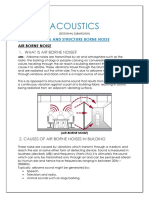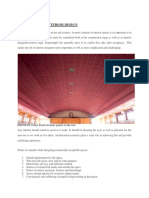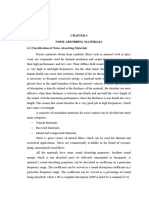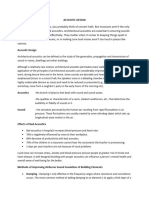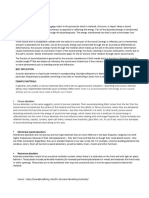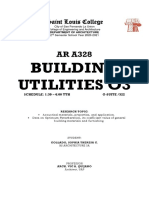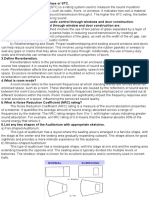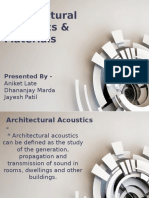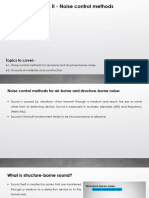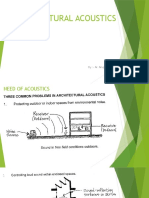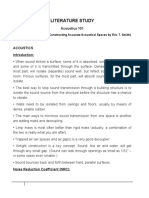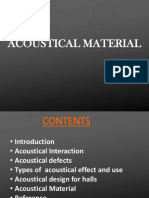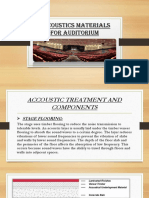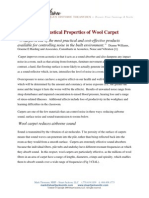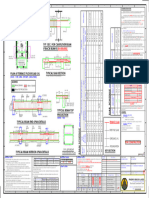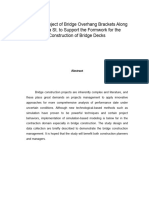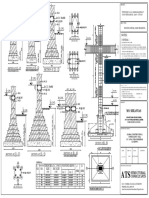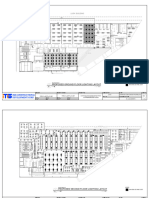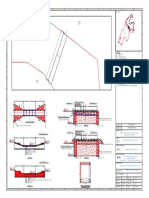0 ratings0% found this document useful (0 votes)
14 viewsAcoustics Seeht Architecture Design
Acoustics Seeht Architecture Design
Uploaded by
Punit BedmuthaAcoustic materials play an important role in controlling sound transmission and reducing noise levels in buildings. They absorb sound energy rather than reflecting it, helping to minimize echoes and reverberation. Common acoustic materials include fiberglass, rock wool, foam plastics, and fabric wall coverings. Proper acoustic treatment of walls, ceilings, doors, and windows can significantly improve soundproofing in homes, offices, studios, and other indoor spaces where noise control is essential. The goal is to reduce unwanted noise transmission and attain the desired sound absorption qualities.
Copyright:
© All Rights Reserved
Available Formats
Download as PDF, TXT or read online from Scribd
Acoustics Seeht Architecture Design
Acoustics Seeht Architecture Design
Uploaded by
Punit Bedmutha0 ratings0% found this document useful (0 votes)
14 views16 pagesAcoustic materials play an important role in controlling sound transmission and reducing noise levels in buildings. They absorb sound energy rather than reflecting it, helping to minimize echoes and reverberation. Common acoustic materials include fiberglass, rock wool, foam plastics, and fabric wall coverings. Proper acoustic treatment of walls, ceilings, doors, and windows can significantly improve soundproofing in homes, offices, studios, and other indoor spaces where noise control is essential. The goal is to reduce unwanted noise transmission and attain the desired sound absorption qualities.
Original Description:
Original Title
Acoustics seeht architecture design
Copyright
© © All Rights Reserved
Available Formats
PDF, TXT or read online from Scribd
Share this document
Did you find this document useful?
Is this content inappropriate?
Report this DocumentAcoustic materials play an important role in controlling sound transmission and reducing noise levels in buildings. They absorb sound energy rather than reflecting it, helping to minimize echoes and reverberation. Common acoustic materials include fiberglass, rock wool, foam plastics, and fabric wall coverings. Proper acoustic treatment of walls, ceilings, doors, and windows can significantly improve soundproofing in homes, offices, studios, and other indoor spaces where noise control is essential. The goal is to reduce unwanted noise transmission and attain the desired sound absorption qualities.
Copyright:
© All Rights Reserved
Available Formats
Download as PDF, TXT or read online from Scribd
Download as pdf or txt
0 ratings0% found this document useful (0 votes)
14 views16 pagesAcoustics Seeht Architecture Design
Acoustics Seeht Architecture Design
Uploaded by
Punit BedmuthaAcoustic materials play an important role in controlling sound transmission and reducing noise levels in buildings. They absorb sound energy rather than reflecting it, helping to minimize echoes and reverberation. Common acoustic materials include fiberglass, rock wool, foam plastics, and fabric wall coverings. Proper acoustic treatment of walls, ceilings, doors, and windows can significantly improve soundproofing in homes, offices, studios, and other indoor spaces where noise control is essential. The goal is to reduce unwanted noise transmission and attain the desired sound absorption qualities.
Copyright:
© All Rights Reserved
Available Formats
Download as PDF, TXT or read online from Scribd
Download as pdf or txt
You are on page 1of 16
By Prasad Ganpule
Relating to sound or the sense of hearing.
The properties or qualities of a room or
building that determine how sound is
transmitted in it.
The branch of physics concerned with the
properties of sound.
A sound that lasts for a long time and makes
things seem to shake or vibrate.
Resonance effect or Echo effect
When the sound intensity is more, then it
gives the great trouble or nuisance to the
particular area like auditorium, cinema hall,
studio, recreation center, entertainment hall,
college reading hall.
Hence it is very important to make that area
or room to be sound proof by using a
suitable material called as ‘Acoustic material’.
It is measured in decibles (db).
Acoustic material play a vital role in the
various area of building construction. The
acoustics treatment is provided to control the
outside as well as inside sound of the various
building unit such that sound will be audible
without any nuisance or disturbance.
These materials eliminate sound reflections
and are generally porous, with many
pathways that redirect sound and cause it to
lose energy.
Typical sound absorbing materials are
fiberglass, rock wool, open cell polyurethane
foam, cellular melamine foam, heavy curtain
blankets and thick fabric wall coverings.
1) Acoustic plaster 2) Fibrous plaster
3) Acoustic tiles 4) Perforated plywood
5) Staw board 6) Pulp board 7) Compressed
fibre board 8) Cork board slabs 9) Foam glass
10) Asbestos cement boards.
11) Thermocoal 12) Foam plastic
13) Chip boards 14) Gasket cork sheet
15) Acoustic foam.
Sound energy is captured and adsorbed.
It has a low reflection and high absorption of sound.
Higher density improves the sound absorption
efficiency at lower frequencies.
Higher density material help to maintain a low
flammability performance. Hence acoustic material
should have higher density.
It controls the sound and noise levels from machinery
and other sources for environmental amelioration and
regulatory compliance.
Acoustic material reduces the energy of sound waves as
they pass through.
It suppresses echoes, reverberation, resonance and
reflection.
Important specifications for noise reduction
and noise absorption products include noise
attenuation and noise reduction coefficient.
A vinyl acoustic barrier blocks controls
airborne noise (street traffic, voices, music)
from passing through a wall ceiling or floor.
Acoustic foam and acoustic ceiling tiles
absorb sound so as to minimize echo and
reverberation within a room.
Sound proof doors and windows are designed
to reduce the transmission of sound.
Building techniques such as double wall
construction or cavity wall construction and
staggering wall studs can improve the sound
proofing of a room.
A sound proof wall (treated by a accurate
material) can incorporate sound proofing and
acoustic materials to meet desired sound
transmission class (STC) values.
Home theatre acoustics.
Wall sound proofing.
Ceiling sound proofing.
Studio Acoustics.
Floor and football sound proofing.
Office and conference room acoustics.
Industrial acoustics.
Pipe sound proofing.
Church and place of worship acoustics.
Restaurant and lounge acoustics.
You might also like
- Special Design Provisions For Wind and Seismic With Commentary - American Wood Council (AWC) 2021Document151 pagesSpecial Design Provisions For Wind and Seismic With Commentary - American Wood Council (AWC) 2021binh.nsbcoNo ratings yet
- C3ECV-U Girder Precast Method StatementDocument34 pagesC3ECV-U Girder Precast Method Statementchingangbam sanathoiNo ratings yet
- Acoustic Design in BuildingsDocument38 pagesAcoustic Design in BuildingsKritika Dhupar100% (2)
- Acoustics: Air Borne Noise and Structure Borne NoiseDocument11 pagesAcoustics: Air Borne Noise and Structure Borne NoiseVISHAL SHARMA100% (1)
- List of Codes - IRC - Pavement & MaterialsDocument4 pagesList of Codes - IRC - Pavement & MaterialsMadhava Reddy N67% (6)
- Architectural AcousticsDocument11 pagesArchitectural Acousticsdanielle caycoNo ratings yet
- Acoustics and Interior DesignDocument5 pagesAcoustics and Interior DesignMohit GuptaNo ratings yet
- What Is Acoustic Absorption?: Acoustic Absorption Refers To The Process by Which A Material, Structure, orDocument12 pagesWhat Is Acoustic Absorption?: Acoustic Absorption Refers To The Process by Which A Material, Structure, orlee blitzNo ratings yet
- Acoustic Insulation MaterialsDocument11 pagesAcoustic Insulation Materialskesavaganesan58No ratings yet
- Thesis CH 4Document9 pagesThesis CH 4princesslayshoonNo ratings yet
- N. Bacalso Avenue, Cebu City, Philippines: Cebu Institute of Technology - University Architecture DepartmentDocument3 pagesN. Bacalso Avenue, Cebu City, Philippines: Cebu Institute of Technology - University Architecture DepartmentEldon Kent SatoNo ratings yet
- Noise Control in Residential BuildingsDocument8 pagesNoise Control in Residential BuildingsPulkitMalikNo ratings yet
- Sound Absorbing PlateDocument13 pagesSound Absorbing Platejohnpaul mosuelaNo ratings yet
- Bu3 ReDocument6 pagesBu3 Refnsi snaiNo ratings yet
- Assignment IdowuDocument5 pagesAssignment IdowuKusel Samuel ThomasNo ratings yet
- Properties of Acoustic Material in A Chosen SpaceDocument10 pagesProperties of Acoustic Material in A Chosen SpaceHanan Mohammed KhalidNo ratings yet
- Fundamentals of Architectural Acoustics: Building Skin EnvelopeDocument85 pagesFundamentals of Architectural Acoustics: Building Skin EnvelopeROA ARCHITECTSNo ratings yet
- الصوت في المتاحفDocument12 pagesالصوت في المتاحفالمعماري ايمن عامرNo ratings yet
- Chapter-2 Sound InsulationDocument40 pagesChapter-2 Sound InsulationDawit TesfayNo ratings yet
- Acoustics PPTDocument22 pagesAcoustics PPTankiw89100% (1)
- Acoustic DesignDocument4 pagesAcoustic Designkeith pulmonesNo ratings yet
- Acoustics RevisionDocument48 pagesAcoustics RevisionnkosentshaNo ratings yet
- Noise Reduction CoefficientDocument10 pagesNoise Reduction CoefficientMarc Joshua CaballeroNo ratings yet
- Acousticalmaterials 180119140257Document15 pagesAcousticalmaterials 180119140257yaredNo ratings yet
- Sound Proof ConstructionDocument20 pagesSound Proof ConstructionSadia Husain100% (1)
- Abutli3s Laude Ass#1Document12 pagesAbutli3s Laude Ass#1viavillas08No ratings yet
- AcousticsDocument2 pagesAcousticsEldon SatoNo ratings yet
- Acoustics 1Document8 pagesAcoustics 1rahsanjiNo ratings yet
- Insulation Material Sound PDFDocument15 pagesInsulation Material Sound PDFKirti gargNo ratings yet
- Building Utilities 3 - Acoustical MaterialsDocument14 pagesBuilding Utilities 3 - Acoustical MaterialsAuthentic SophiaNo ratings yet
- Acoustics Sem5 PDFDocument34 pagesAcoustics Sem5 PDF19SA155. SrushtiNo ratings yet
- Acoustics NotesDocument12 pagesAcoustics NotesKavinraj KNo ratings yet
- Acoustics and ArchitectureDocument46 pagesAcoustics and ArchitectureAbraham BongolanNo ratings yet
- Acoustic Materials: Research About Different Kinds of Materials For Traffic Noise BarriersDocument12 pagesAcoustic Materials: Research About Different Kinds of Materials For Traffic Noise BarriersEphremZelekeNo ratings yet
- Architectural AcousticsDocument22 pagesArchitectural AcousticsJayesh PatilNo ratings yet
- AR-407 Building Services-III: Assignment-5Document17 pagesAR-407 Building Services-III: Assignment-5MOHD NAZEEF KHANNo ratings yet
- Acoustical Material Fabric Wrapped PanelsDocument11 pagesAcoustical Material Fabric Wrapped PanelsPrakarti LullaNo ratings yet
- Concert Halls by Group 5Document30 pagesConcert Halls by Group 5Ayesha AnnNo ratings yet
- Acoutics Unit No 2 and 3Document41 pagesAcoutics Unit No 2 and 3vaishnavi pawarNo ratings yet
- Architectural Acoustics (Also Known AsDocument8 pagesArchitectural Acoustics (Also Known Asmat bondocNo ratings yet
- Sound Absorbing MaterialsDocument13 pagesSound Absorbing MaterialsKirstie Ann Lee - Cortes100% (1)
- Interior Environmental Analysis: Presentation 07Document17 pagesInterior Environmental Analysis: Presentation 07jeevaNo ratings yet
- AcousticsDocument34 pagesAcousticsanuj seth50% (2)
- Week 5 Building Utilities 3Document46 pagesWeek 5 Building Utilities 3Garry BalintecNo ratings yet
- Acoustic Panels: by Saumya Verma and Sanya ShandilyaDocument15 pagesAcoustic Panels: by Saumya Verma and Sanya ShandilyaSaumya VermaNo ratings yet
- BU3 Week 2 Lecture Room AcousticDocument35 pagesBU3 Week 2 Lecture Room Acousticria dcNo ratings yet
- Literature Study: Acoustics 101Document11 pagesLiterature Study: Acoustics 101inia chezhianNo ratings yet
- Acoustic MaterialsDocument6 pagesAcoustic Materialstejaswini C gaurNo ratings yet
- Acoustic MaterialDocument4 pagesAcoustic MaterialAbdulrahimMagomuNo ratings yet
- Acoustical MaterialDocument31 pagesAcoustical MaterialVISHAL SHARMANo ratings yet
- AcousticalmaterialDocument40 pagesAcousticalmaterialNagesh PoolaNo ratings yet
- Acoustics Materials On Sound AbsorptionDocument11 pagesAcoustics Materials On Sound AbsorptionlikhithNo ratings yet
- Acoustic MaterialsDocument16 pagesAcoustic MaterialsSansar PanchalNo ratings yet
- Accoustics Materials For AuditoriumDocument11 pagesAccoustics Materials For Auditoriumazka mushirNo ratings yet
- Accoustics Materials For AuditoriumDocument11 pagesAccoustics Materials For Auditoriumazka mushirNo ratings yet
- Sound Absorption and Treatment - 1Document5 pagesSound Absorption and Treatment - 1B ErNo ratings yet
- Importance of Acoustic MaterialsDocument15 pagesImportance of Acoustic MaterialsNikunj DwivediNo ratings yet
- SREELAKSHMIDocument18 pagesSREELAKSHMIklsindhu049No ratings yet
- Acoustical Materials / Fireproofing MaterialsDocument26 pagesAcoustical Materials / Fireproofing MaterialsPrerana borlagadaNo ratings yet
- AcousticsDocument42 pagesAcousticstwinkle4545No ratings yet
- Acoustic Properties Wool CarpetDocument5 pagesAcoustic Properties Wool CarpetGoreti CertalNo ratings yet
- Electrical WorkDocument13 pagesElectrical WorkPunit BedmuthaNo ratings yet
- D-For Psa-For Psa - Psa 9117 - S - 23 - RC Details of Terrace Floor Slab - MR - Kiran Dada-r0-ModelDocument1 pageD-For Psa-For Psa - Psa 9117 - S - 23 - RC Details of Terrace Floor Slab - MR - Kiran Dada-r0-ModelPunit BedmuthaNo ratings yet
- Twin Bunglow Plan-ModelDocument1 pageTwin Bunglow Plan-ModelPunit BedmuthaNo ratings yet
- 11Document1 page11Punit BedmuthaNo ratings yet
- RwallDocument51 pagesRwallandualemNo ratings yet
- JICA Assisted Guwahati Water Supply Project (ID P-201)Document33 pagesJICA Assisted Guwahati Water Supply Project (ID P-201)Alakesh PhukanNo ratings yet
- XCMG Xe150wdDocument6 pagesXCMG Xe150wdmulyadi workNo ratings yet
- NBS Reference SpecificationDocument282 pagesNBS Reference Specificationmickolakis2100% (6)
- ProductDocument732 pagesProductAngel LoorNo ratings yet
- A330 - AMM - 25-50-00-340-816-A - Repair of The Decompression Panels in The Cargo CompartmentsDocument10 pagesA330 - AMM - 25-50-00-340-816-A - Repair of The Decompression Panels in The Cargo Compartmentssah3liNo ratings yet
- ThesisDocument4 pagesThesisJam MiculobNo ratings yet
- Portland Cement ConcreteDocument15 pagesPortland Cement ConcreteIm ChinithNo ratings yet
- QS QuizDocument2 pagesQS Quizmuhammad syamimNo ratings yet
- Project Name: Pull Planning BoardDocument3 pagesProject Name: Pull Planning BoardJay Mark ArbuesNo ratings yet
- KNT Attachment GuideDocument125 pagesKNT Attachment GuideALEX DIEGONo ratings yet
- BSR NH Circle Jaipur 2024Document115 pagesBSR NH Circle Jaipur 2024Arti ManojNo ratings yet
- Kapitan Ambo - Electrical Plans-Model - pdf12Document1 pageKapitan Ambo - Electrical Plans-Model - pdf12Allen Edward YapNo ratings yet
- Ø101 Boru Bükme-ModelDocument1 pageØ101 Boru Bükme-ModelUğur BölükbaşıNo ratings yet
- Footing DetailDocument1 pageFooting DetailRatnesh PatelNo ratings yet
- Civildatas - Blogspot.in: MahalakshmiDocument13 pagesCivildatas - Blogspot.in: MahalakshmiveluNo ratings yet
- To All of You - Syd MattersDocument1 pageTo All of You - Syd MattersИВАН ЗДВАРДОNo ratings yet
- Building System Standards and Design GuideDocument348 pagesBuilding System Standards and Design Guidejackcan501No ratings yet
- Safe Working in The Vicinity of Gas Pipelines Mains and Associated InstallationsDocument16 pagesSafe Working in The Vicinity of Gas Pipelines Mains and Associated InstallationsReda GuellilNo ratings yet
- CV Alin-Andrei Angiu enDocument4 pagesCV Alin-Andrei Angiu encatalin alinNo ratings yet
- Restoration, Written by Viollet-le-Duc ReviewDocument3 pagesRestoration, Written by Viollet-le-Duc ReviewAysegul AkınNo ratings yet
- Interior and Exterior MaterialsDocument51 pagesInterior and Exterior MaterialsMyla LayanNo ratings yet
- Electrical Plan - Davao ProjectDocument13 pagesElectrical Plan - Davao ProjectPhil's ChannelNo ratings yet
- Ma'am Anna Bianca R. MoralesDocument1 pageMa'am Anna Bianca R. MoralesTimothy James M. MadridNo ratings yet
- M - E T - C PICO Hose Reel Tank - AcessDocument2 pagesM - E T - C PICO Hose Reel Tank - AcesskassthureiNo ratings yet
- Standard Practice For Agencies Testing Concrete and Concrete Aggregates For Use in Construction and Criteria For Testing Agency EvaluationDocument5 pagesStandard Practice For Agencies Testing Concrete and Concrete Aggregates For Use in Construction and Criteria For Testing Agency Evaluationming_zhu10No ratings yet
- Rpipl Up2 FP Ce DWG Misc 006Document1 pageRpipl Up2 FP Ce DWG Misc 006aaaaNo ratings yet



